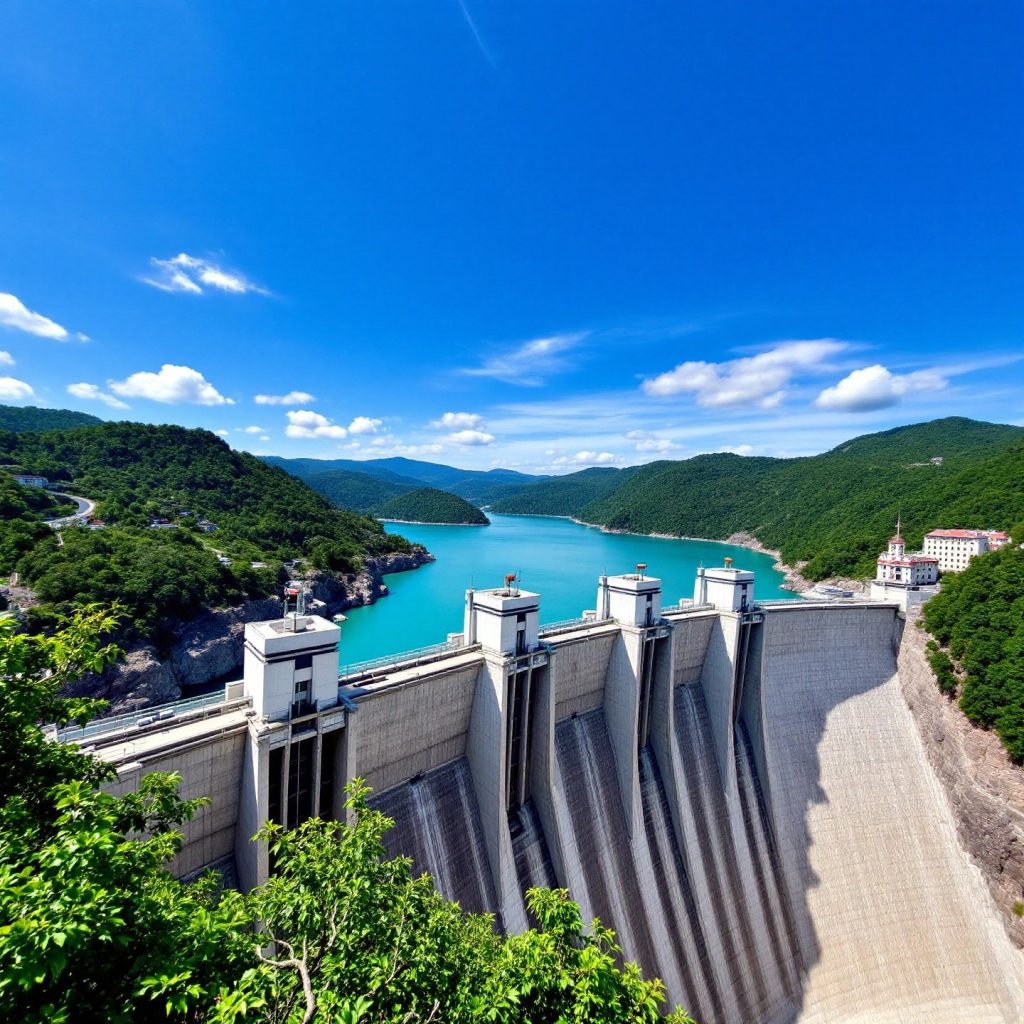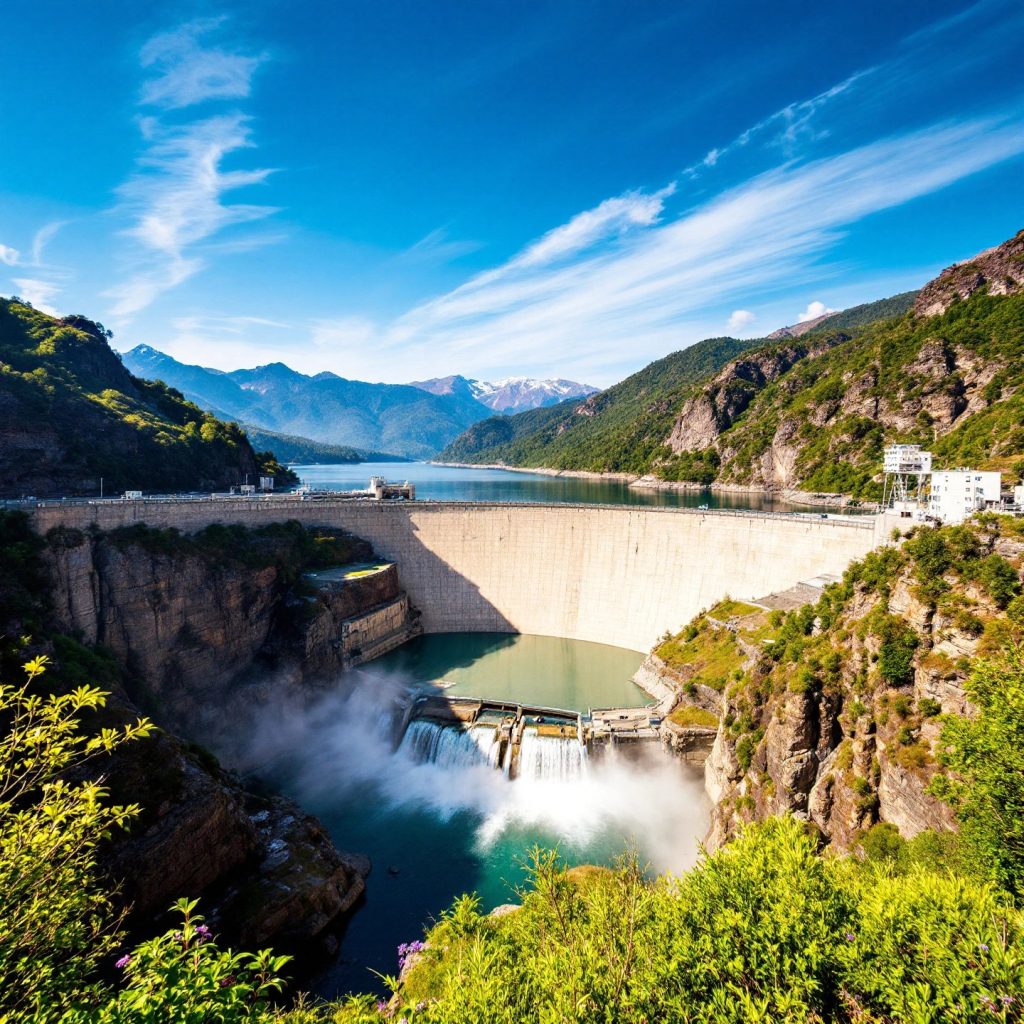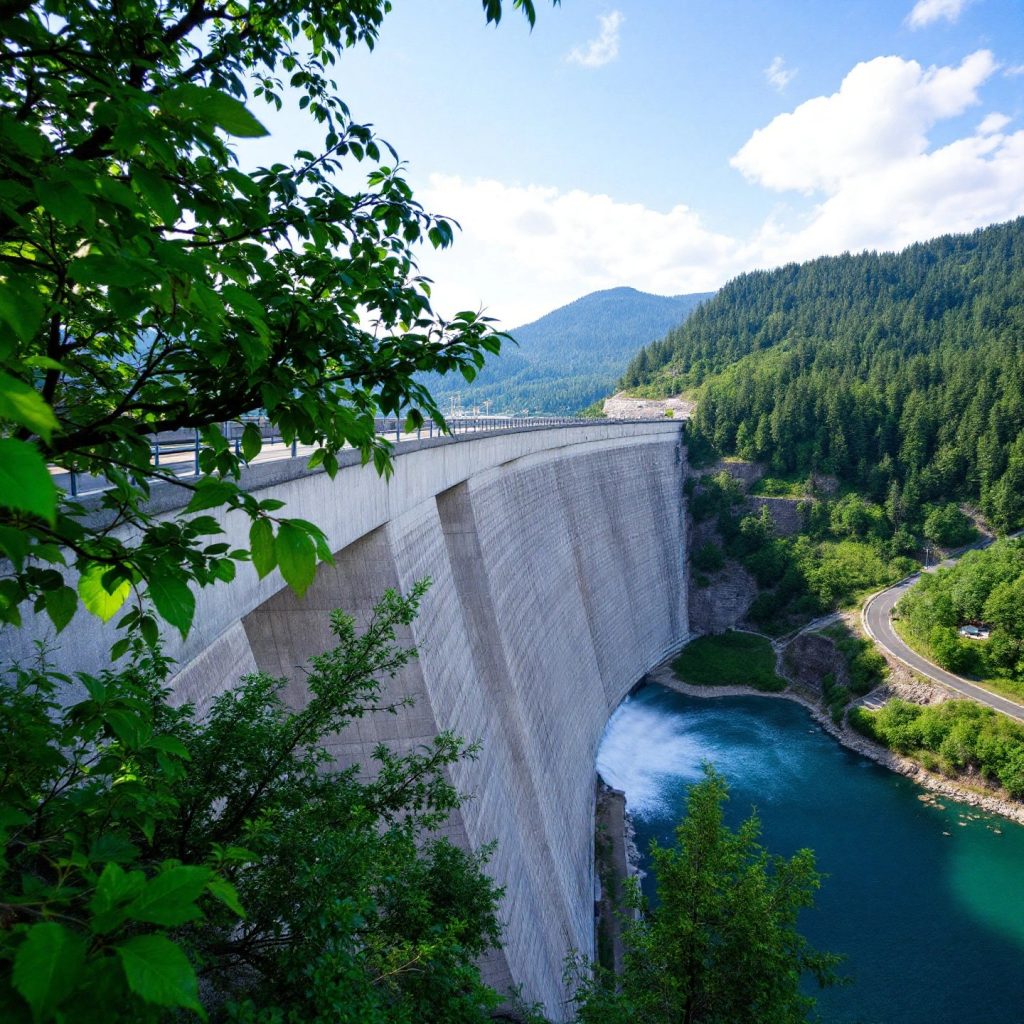Introduction to Hydropower Turbine
Imagine harnessing the power of flowing water to generate electricity without the harmful emissions associated with fossil fuels. This is the promise of hydropower turbines, a cornerstone of renewable energy technologies. As the world increasingly turns to sustainable sources to meet its growing energy demands, hydropower turbines have emerged as a vital player in the quest for cleaner energy.
Hydropower turbines operate by converting the kinetic energy of flowing water into mechanical energy, which is then transformed into electricity. This process not only provides a reliable source of energy but also plays a crucial role in reducing carbon footprints globally. According to the USGS , hydropower is one of the most efficient methods of generating electricity, leveraging natural water cycles to produce power sustainably.
The global interest in water energy is not just a trend but a necessity for sustainable development. Water is at the core of socio-economic growth, as highlighted by the United Nations . As countries strive to balance commercial demands with environmental preservation, hydropower offers a pathway to achieving these goals. Its ability to provide consistent and renewable energy makes it an attractive option for nations looking to meet their energy needs while also adhering to climate change commitments.
In this blog, we will explore the fundamentals of hydropower turbines, delve into various market insights, and examine practical applications. From understanding how these turbines work to navigating the latest industry trends, this comprehensive guide aims to equip you with the knowledge needed to appreciate the transformative power of hydropower turbines.
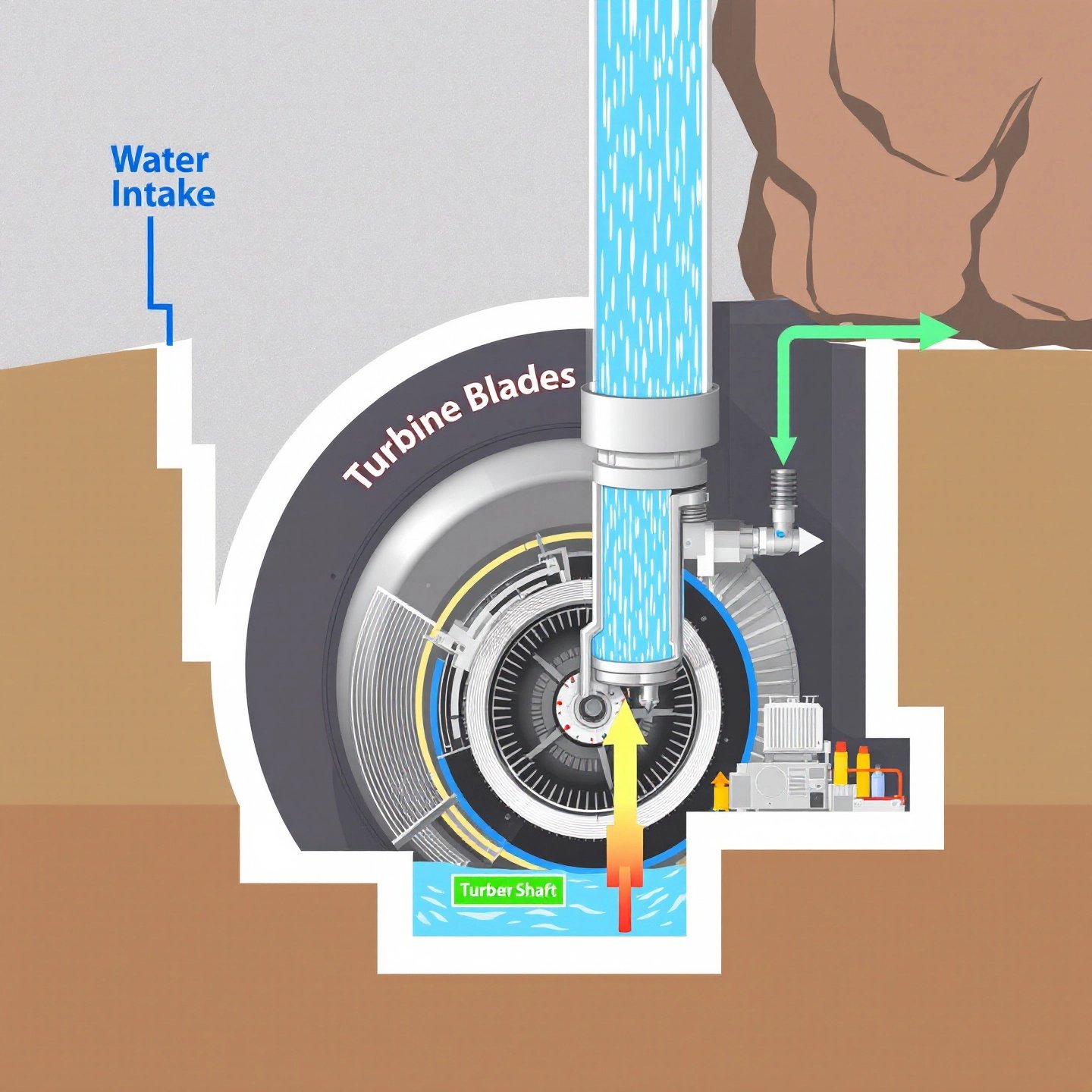
Understanding Hydropower Turbine Fundamentals
Have you ever wondered, “How does a hydropower turbine work?” At its core, the operation of a hydropower turbine is a fascinating dance of physics and engineering. Let’s break it down into simpler terms:
- Water Flow: The journey begins as water from a river or reservoir flows through a penstock, a channel that directs the water towards the turbine. The force of this water flow is crucial, as it determines the energy potential available for conversion.
- Kinetic Energy Transfer: As the water strikes the turbine blades, it transfers its kinetic energy, causing the blades to spin. This spinning motion is the heart of the turbine’s function, converting the energy of moving water into mechanical energy.
- Generator Function: The mechanical energy generated from the spinning turbine is then converted into electrical energy via a generator. This electricity is then transmitted to power grids for distribution.
Several factors influence the efficiency of a hydropower turbine:
- Flow Rate: The volume of water flowing through the turbine per unit of time is critical. Higher flow rates generally mean more energy can be generated.
- Head: This refers to the height difference between the water source and the turbine. A greater head results in more potential energy, thus increasing the turbine’s efficiency.
- Turbine Materials: The materials used in turbine construction can affect performance. Durable materials that resist wear and corrosion are essential for maintaining efficiency over time.
Understanding these basics not only explains how a hydropower turbine works but also emphasizes the importance of optimizing each component to enhance overall efficiency. As we delve deeper into the world of hydropower, you’ll discover how these principles are applied across various turbine designs, each tailored to specific environmental and operational conditions.
Examining Key Types and Essential Designs of Hydropower Turbines
When it comes to hydropower turbine types, understanding the distinct designs and their applications is crucial for optimizing energy generation. Each type of turbine is tailored to specific environmental conditions, notably the head level and flow rate of the water source. Let’s explore the major designs and their unique features.
Impulse Turbines
Impulse turbines, such as the Pelton and cross-flow turbines, are ideal for high-head, low-flow situations. These turbines utilize the velocity of water to move the runner, with water jets striking the turbine blades to generate power.
- Pelton Turbine: Best suited for very high heads, Pelton turbines feature spoon-shaped buckets that capture water jets, maximizing energy transfer. They are highly efficient in mountainous regions with steep water drops.
- Cross-Flow Turbine: Designed for medium heads and low flows, cross-flow turbines allow water to pass through the blades twice, increasing efficiency. Their drum-like shape is particularly effective in small-scale applications.
Reaction Turbines
Reaction turbines, including the Francis and Kaplan types, operate under lower head and higher flow conditions. They harness both the pressure and the kinetic energy of water, with the runner fully submerged.
- Francis Turbine: Versatile and widely used, the Francis turbine is suitable for medium to high heads. Its inward-flowing design makes it efficient for large-scale power plants.
- Kaplan Turbine: Known for its adjustable blades, the Kaplan turbine is ideal for low-head, high-flow environments. Its design allows for optimal performance in rivers and tidal applications.
Comparative Analysis
| Turbine Type | Design Features | Head Requirements | Efficiency Range |
|---|---|---|---|
| Pelton | Impulse, spoon-shaped buckets | High (300-1,800 meters) | 85-90% |
| Cross-Flow | Impulse, drum-shaped | Medium (10-70 meters) | 75-85% |
| Francis | Reaction, inward-flowing | Medium to High (20-300 meters) | 90-95% |
| Kaplan | Reaction, adjustable blades | Low (2-20 meters) | 80-90% |
Choosing the right water turbine hydropower system involves assessing site-specific conditions to match the turbine type with the environmental parameters. This ensures optimal performance and maximizes energy output, making hydropower a viable and sustainable energy source. As we continue our exploration, we will delve into enhancing turbine efficiency and overcoming performance challenges.
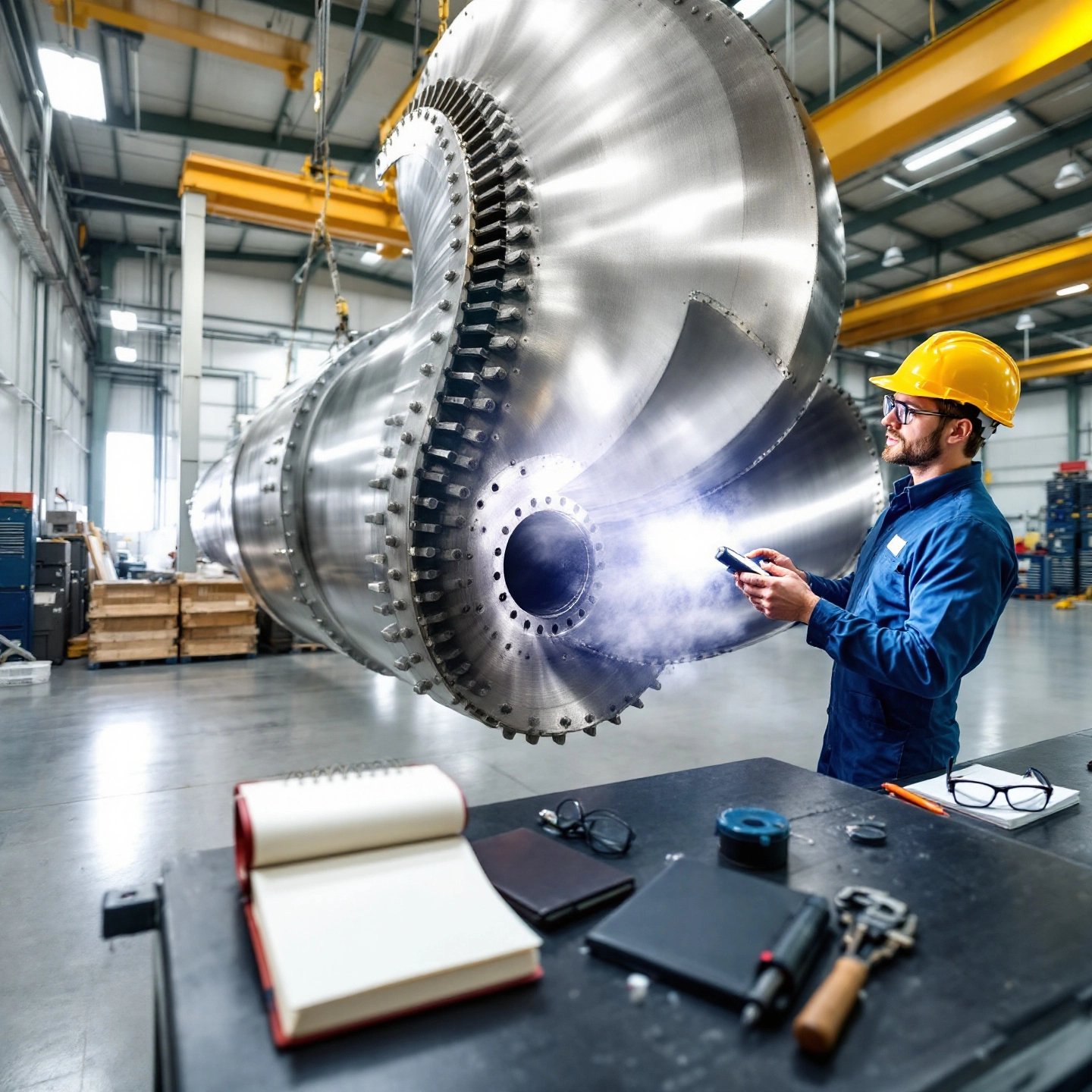
Improving Efficiency and Resolving Performance Challenges in Hydropower Turbines
Imagine your hydropower turbine operating at peak efficiency, consistently delivering energy without a hitch. Sounds ideal, right? But achieving this requires addressing several factors that can impact performance. Let’s dive into the critical aspects of hydropower turbine efficiency and explore how to tackle common challenges like corrosion.
Factors Influencing Hydropower Turbine Efficiency
- Blade Materials: The choice of materials for turbine blades is crucial. High-strength alloys and corrosion-resistant composites are often used to withstand the harsh aquatic environment and reduce wear.
- Operational Wear: Over time, continuous operation can lead to wear and tear. Regular maintenance and monitoring are essential to detect early signs of degradation and address them promptly.
- Flow Dynamics: Ensuring optimal water flow through the turbine enhances energy conversion. Adjustments in blade angle or turbine positioning can significantly improve efficiency.
Combating Corrosion in Turbines
Corrosion is a silent enemy that can drastically reduce the lifespan and efficiency of hydropower turbines. Here are some strategies to minimize its impact:
- Material Selection: Using corrosion-resistant materials, such as stainless steel or specialized coatings, can protect turbine components from corrosive elements in water.
- Regular Inspections: Implementing a routine inspection schedule helps identify early signs of corrosion, allowing for timely interventions.
- Water Chemistry Management: Maintaining proper water chemistry is vital. Controlling pH levels and minimizing impurities can prevent corrosive reactions. For more insights on preventing turbine corrosion, check out this detailed guide.
Enhancing Durability with Renewable Energy Nexus Solutions
Imagine integrating cutting-edge solutions to bolster your hydropower setup. Renewable Energy Nexus offers innovative products that can complement hydropower systems, enhancing durability and efficiency. By incorporating solar panels, you can create a hybrid energy system that maximizes resource utilization and provides a backup during low-water periods. Explore their offerings here.
By understanding and addressing these efficiency and durability challenges, you can ensure your hydropower turbine operates at its best, contributing to a sustainable and reliable energy future. As we move forward, we will explore market trends and cost considerations, guiding you through the economic landscape of hydropower turbines.
Navigating Market Availability and Cost Considerations for Hydropower Turbines
When considering the implementation of hydropower turbines, understanding the market landscape and cost implications is crucial. From initial investment to long-term maintenance, various factors influence the overall cost and availability of these renewable energy solutions. Let’s explore the key elements affecting hydropower turbine costs and market trends.
Key Cost Factors for Hydropower Turbines
Several elements contribute to the cost of hydropower turbines, ranging from the turbine type to the complexity of installation. Here’s what you need to consider:
- Size and Capacity: Larger turbines with higher capacity naturally incur higher costs. For instance, a 5 kW micro hydropower turbine system can range from $15,000 to $55,000, depending on site-specific requirements and turbine type (source).
- Brand and Manufacturer: The choice of manufacturer can significantly impact cost. Established brands often offer advanced technology and reliability, which may come at a premium.
- Installation Complexity: The geographical location and site conditions influence installation costs. Remote or difficult-to-access sites typically require more resources, increasing the overall expenditure.
- Auxiliary Components: Additional components such as generators, powerhouses, and water intake systems add to the total cost. These can vary widely based on design and quality.
Market Trends and Availability
The hydropower market is evolving, with trends leaning towards both large-scale projects and smaller, distributed systems. As the industry grows, so does the availability of hydropower turbines for sale. Here are some trends to watch:
- Increased Demand for Small-Scale Systems: There’s a rising interest in micro and small hydropower systems, especially in regions with untapped water resources. These systems are more accessible and often benefit from government incentives.
- Technological Advancements: Innovations in turbine design and materials are enhancing efficiency and reducing costs, making hydropower more competitive with other renewable sources.
- Policy Support: Many governments are implementing favorable policies, such as feed-in tariffs, to encourage hydropower development, further boosting market availability.
Cost Range Summary for Different Turbine Types
| Turbine Type | Cost Range | Capacity |
|---|---|---|
| Pelton | $10,000 – $50,000 | 5 kW – 100 kW |
| Francis | $20,000 – $100,000 | 10 kW – 1 MW |
| Kaplan | $15,000 – $80,000 | 5 kW – 500 kW |
Understanding these cost factors and market trends is essential for making informed decisions when investing in hydropower turbines. As the industry continues to innovate and expand, staying abreast of these developments will help you navigate the economic landscape effectively. Next, we’ll explore emerging trends in hydropower turbine manufacturing and the role of key industry players.
Exploring Industry Trends and Manufacturer Options in Hydropower Turbines
In the ever-evolving landscape of renewable energy, hydropower turbine manufacturing is witnessing significant advancements. As the demand for sustainable energy solutions grows, manufacturers are innovating with eco-friendly designs and digital monitoring technologies to enhance turbine performance and reliability. Let’s delve into the current trends shaping the industry and the key players leading the charge.
Eco-Friendly Designs and Digital Monitoring
Manufacturers are increasingly focusing on creating hydropower turbines that minimize environmental impact. This includes the use of sustainable materials and designs that reduce ecological disruption. For example, some companies are developing fish-friendly turbines that allow aquatic life to pass through safely, reflecting a commitment to biodiversity preservation.
Moreover, digital monitoring systems are becoming a staple in modern hydropower setups. These systems utilize sensors and data analytics to optimize turbine operations, predict maintenance needs, and enhance overall efficiency. This technological integration not only improves performance but also extends the lifespan of hydropower installations.
Leading Hydropower Turbine Manufacturers
The hydropower turbine market is dominated by several key players who are setting industry standards through innovation and quality. Notable manufacturers include:
- General Electric Co: Known for its advanced turbine technology and extensive global reach.
- Andritz AG: A leader in providing comprehensive solutions that integrate cutting-edge technology with sustainable practices.
- Voith GmbH & Co KGaA: Specializes in high-efficiency turbines and offers robust after-sales service to ensure long-term reliability.
- Dongfang Electric Corporation Ltd: Renowned for its large-scale production capabilities and innovative designs.
These manufacturers, along with others like Harbin Electric Corp and Toshiba Corp, hold a significant share of the market, collectively driving advancements in turbine technology.
The Importance of After-Sales Service and Sustainable Manufacturing
After-sales service is a critical component of the hydropower turbine industry. Manufacturers are increasingly focusing on providing comprehensive service packages that include regular maintenance, technical support, and spare parts availability. This ensures the longevity and optimal performance of hydropower systems.
Furthermore, sustainable manufacturing processes are gaining traction. Companies are adopting green practices, such as reducing waste and energy consumption during production, aligning with global sustainability goals. Government policies also play a pivotal role, with many countries offering incentives for manufacturers who adhere to eco-friendly standards.
As we continue our exploration of hydropower turbines, understanding these industry trends and manufacturer options can guide you in selecting reliable systems that align with both environmental and operational needs. Next, we’ll delve into the power output capabilities and environmental impacts of different turbine generators, offering insights into selecting the right system for your energy requirements.
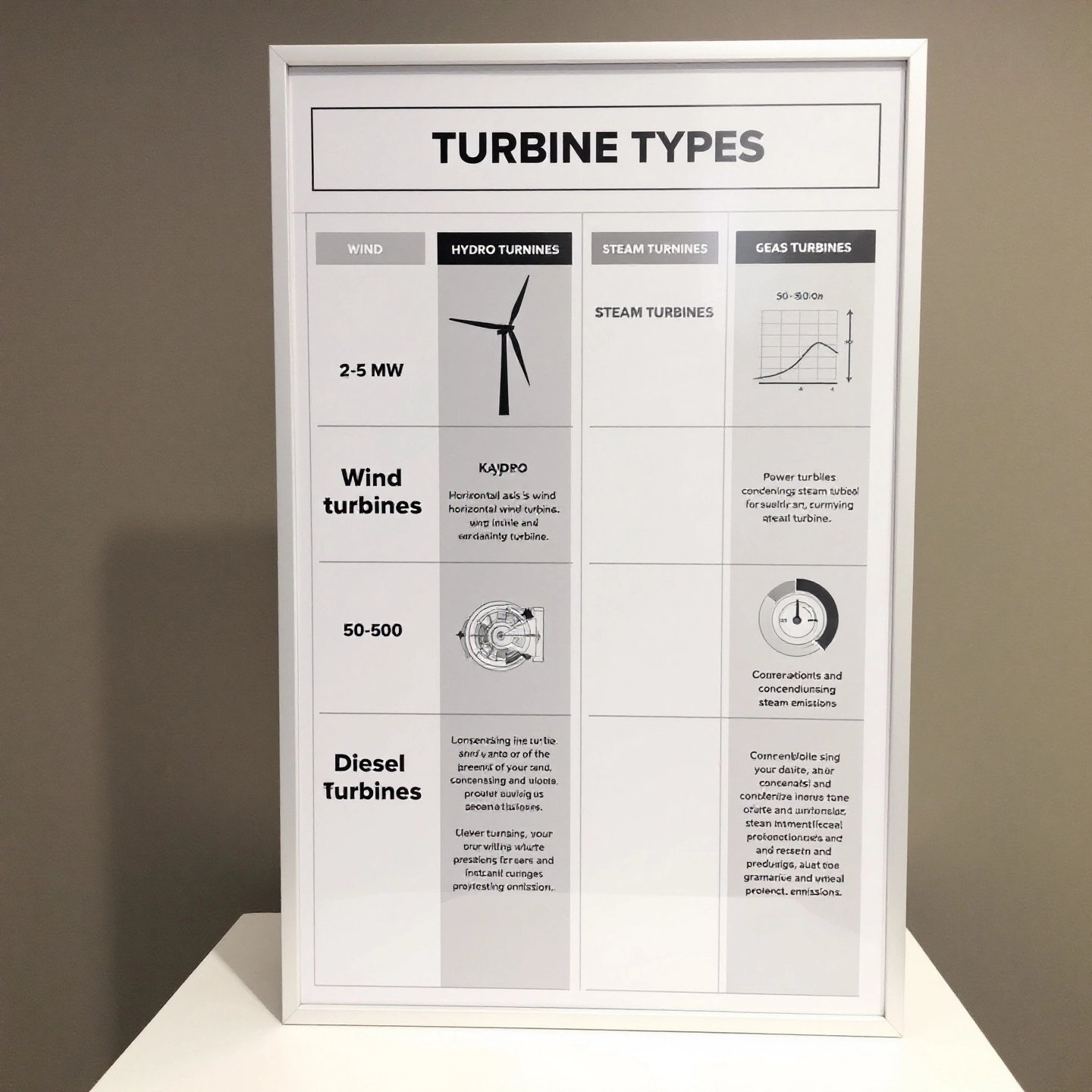
Selecting Reliable Turbine Generators for Different Needs
Choosing the right hydropower turbine generator involves evaluating both power output capabilities and environmental impacts. Understanding these factors ensures that your selection aligns with your energy needs and sustainability goals.
Power Output Capabilities
Hydropower turbine generators vary significantly in their power output, which is influenced by design, head, and flow rate. Here’s a brief comparison:
- Pelton Turbines: Ideal for high-head, low-flow scenarios, these turbines are capable of delivering high efficiency and power output in mountainous regions.
- Kaplan Turbines: Suited for low-head, high-flow conditions, Kaplan turbines are perfect for river and tidal applications, offering adjustable blades for optimal performance.
- Francis Turbines: These versatile turbines can handle a wide range of head and flow conditions, making them a popular choice for medium to large-scale power plants.
Environmental Impacts
While hydropower is a cleaner energy source, the installation and operation of turbines can impact local ecosystems. Consider these factors:
- Fish-Friendly Designs: Newer turbines incorporate features that allow aquatic life to pass safely, reducing ecological disruption.
- Minimal Land Use: Compact turbine designs help preserve natural landscapes, an essential consideration for environmentally sensitive areas.
Supplementing with Solar Panels
For off-grid setups, combining hydropower with solar panels can enhance energy reliability. Renewable Energy Nexus offers a range of solar solutions that complement hydropower systems, providing a steady power supply even during low-water periods. Explore their offerings here.
Selection Criteria
When selecting a hydropower turbine generator, consider the following criteria:
- Site Conditions: Evaluate the head and flow rate to determine the most suitable turbine type.
- Energy Needs: Match the generator’s capacity with your energy consumption requirements.
- Environmental Impact: Choose designs that minimize ecological disruption and align with sustainability goals.
- Cost and Maintenance: Consider the initial investment and long-term maintenance costs to ensure economic feasibility.
By carefully considering these factors, you can select a turbine generator that not only meets your energy needs but also supports your commitment to environmental sustainability. As we continue, we’ll explore the practical applications of micro and small-scale hydropower systems in various settings.
Applying Micro and Small-Scale Systems in Real-World Settings
Imagine transforming a gentle stream running through your property into a reliable source of electricity. This is the promise of micro and small hydropower systems, which are perfect for residential and small-business applications. These systems provide a sustainable way to harness energy, especially in remote locations where traditional power grids may not reach.
Understanding Micro and Small-Scale Hydropower Systems
Micro hydropower systems, typically generating up to 100 kilowatts, are ideal for powering homes, small resorts, and farms. These systems use a micro hydropower turbine to convert the energy of flowing water into electricity. Small-scale systems, on the other hand, can be slightly larger but still focus on providing power to localized areas. Both types of systems offer a consistent and renewable energy source, leveraging the natural flow of water without significant environmental disruption.
Site Assessment Tips
Before setting up a micro or small hydropower system, it’s crucial to conduct a thorough site assessment. Here are some key considerations:
- Water Flow: Determine the volume of water available. Consistent flow is essential for reliable energy production. Techniques like the bucket-and-weir method can help estimate flow rate accurately.
- Head Measurement: The vertical drop of water, or head, is a critical factor. Greater head translates to more potential energy. Tools like altimeters or GPS units can provide an estimate of the head available at your site.
- Environmental Impact: Consider the ecological effects of your system. Choose locations that minimize disturbance to local wildlife and water ecosystems.
Scalability and Mobility in Remote Areas
One of the standout features of micro and small hydropower systems is their scalability and mobility. These systems can be adapted to fit various site conditions and can be relocated if necessary. This flexibility makes them particularly valuable in remote areas where infrastructure development is challenging.
For instance, a small hydropower turbine can be installed on a temporary basis to provide energy during construction projects or in disaster relief scenarios. Their ability to operate independently of the grid also makes them an excellent choice for off-grid communities seeking energy independence.
By leveraging the natural power of water, micro and small hydropower systems offer a practical and eco-friendly solution for sustainable energy generation. As we continue our exploration, we will delve into large-scale hydropower installations and the innovative projects pushing the boundaries of this technology.
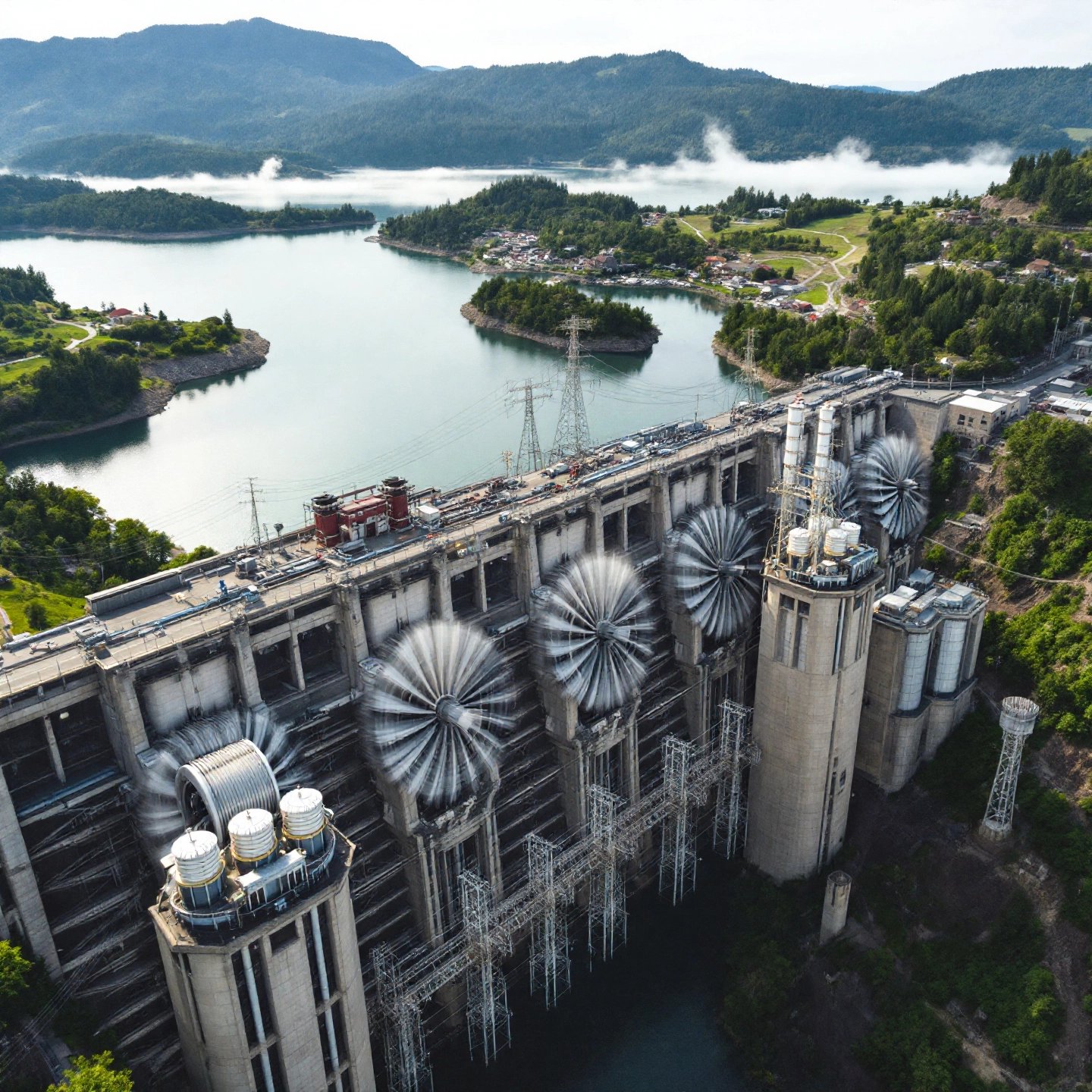
Scaling Up with Large-Scale Solutions and Innovative Projects
When you think of hydropower, large-scale installations often come to mind, capturing the imagination with their sheer size and the volume of energy they can generate. But what goes into creating these massive hydropower plant turbines, and how do they fit into our sustainable energy future?
Design Complexities of Large-Scale Hydropower Plants
Large-scale hydropower plants are engineering marvels, requiring meticulous planning and execution. The design of these plants involves constructing massive dams that create reservoirs, which store water to be released through turbines as needed. This controlled release of water ensures a steady supply of electricity, making hydropower a reliable energy source. However, the construction of such plants is not without its challenges.
- Site Selection: Choosing a suitable location is crucial. The site must have sufficient water flow and head to justify the investment, while also considering the environmental impact.
- Infrastructure Development: Building the necessary infrastructure, such as roads and transmission lines, in often remote areas can be costly and time-consuming.
- Environmental Impact: Large-scale projects can disrupt local ecosystems, affect fish populations, and lead to the displacement of communities. Mitigation measures, such as fish ladders and habitat restoration, are essential to minimize these impacts.
Innovative Research on Reversible Pump-Turbine Systems
One of the groundbreaking advancements in hydropower technology is the development of reversible turbine pump hydropower plants. These systems play a vital role in energy storage and grid stability, addressing some of the limitations of traditional hydropower.
Reversible pump-turbine systems allow water to be pumped back into the reservoir during periods of low electricity demand, effectively storing energy for later use. This capability is crucial for balancing supply and demand, especially as more intermittent renewable sources like wind and solar are integrated into the grid. According to MDPI, these systems are highly efficient, with the ability to switch between generating and storing energy seamlessly, thus enhancing grid reliability and stability.
Environmental Considerations and Future Prospects
While large-scale hydropower plants offer significant benefits, their environmental and social impacts cannot be overlooked. Comprehensive environmental assessments and community engagement are crucial to address potential adverse effects. Innovative projects are increasingly focusing on sustainability, incorporating features like fish-friendly turbines and enhanced sediment management to mitigate environmental concerns.
Looking ahead, the future of large-scale hydropower lies in integrating advanced technologies and sustainable practices. As research continues to evolve, the potential for more efficient and environmentally friendly hydropower solutions grows, ensuring these installations can contribute positively to global energy needs while respecting ecological boundaries.
As we explore these large-scale solutions, it’s clear that innovation and careful planning are key to harnessing the full potential of hydropower turbines. Next, we will delve into the conclusion, summarizing the pivotal role of hydropower in sustainable energy strategies and encouraging the pursuit of integrated renewable solutions.
Conclusion
As we conclude our exploration of hydropower turbines, it’s clear that these powerful machines are pivotal in achieving sustainable energy goals. By harnessing the natural energy of flowing water, hydropower turbines offer a renewable and reliable power source, significantly contributing to the reduction of carbon emissions and supporting the global transition to cleaner energy systems.
Hydropower’s role in sustainable energy is underscored by its capacity to integrate with other renewable technologies. Imagine a future where hydropower, solar, and wind energy work in harmony, creating a balanced and resilient energy grid. Such integrated renewable strategies are essential for meeting the diverse and growing energy needs of our planet while minimizing environmental impact.
Advancements in technology continue to enhance the efficiency and environmental compatibility of hydropower turbines. Innovations such as fish-friendly designs and digital monitoring systems are making these turbines more sustainable and less intrusive to local ecosystems. These technological strides ensure that hydropower remains a cornerstone of renewable energy solutions.
For those looking to explore comprehensive renewable energy solutions, platforms like Renewable Energy Nexus offer valuable resources and products. Their range of solar panels complements hydropower systems, providing a versatile and cost-effective way to enhance energy reliability. By integrating such technologies, you can optimize your energy setup, ensuring both environmental and economic benefits.
In summary, hydropower turbines are more than just machines—they are key players in the global effort to achieve sustainable energy goals. By embracing advanced technologies and integrated renewable strategies, we can pave the way for a cleaner, greener future. As you consider your energy options, remember that the choices you make today will shape the world of tomorrow. Let’s commit to a sustainable path, exploring the full potential of hydropower and beyond.
Frequently Asked Questions about Hydropower Turbines
1. What is a turbine in hydropower?
A hydropower turbine converts the kinetic energy of water into mechanical energy, which is then turned into electricity. These turbines are efficient, converting over 90% of water’s kinetic energy into mechanical energy, making them essential for renewable energy generation.
2. Can a water turbine power a house?
Yes, a microhydropower system, typically around 10 kilowatts, can power a large home or small business. These systems utilize a turbine to convert the energy of flowing water into electricity, offering a sustainable energy solution for off-grid locations.
3. How much electricity does a hydro turbine generate?
The electricity generated by a hydro turbine depends on its capacity and operational hours. For example, a 500W turbine can produce around 4,000kWh annually, sufficient for a reasonably energy-efficient home.
4. What is the most efficient type of hydro turbine?
Pelton turbines are among the most efficient, especially in high-head scenarios. They convert the fluid power into kinetic energy with minimal pressure drop, making them highly effective in mountainous regions.
5. What are the environmental impacts of hydropower turbines?
Hydropower turbines can affect local ecosystems, but innovations like fish-friendly designs and compact structures help minimize these impacts. They provide a cleaner energy source compared to fossil fuels, supporting environmental sustainability.

